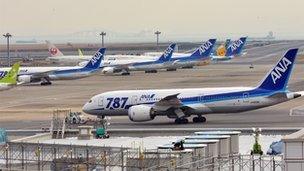Dreamliner battery redesign approved by FAA
- Published

Boeing's Dreamliner fleet has been grounded while safety checks are carried out on their batteries
The US airline regulator has approved a plan to redesign the lithium-ion batteries of the Boeing 787 Dreamliner.
The Federal Aviation Administration (FAA) approved Boeing's plan, external, which it said requires it to "conduct extensive testing and analysis".
But the FAA gave no indication of when the planes might be allowed to carry passengers again.
All 50 Dreamliners in operation were grounded after the batteries emitted smoke on several separate occasions.
The plane is the first plane in the world to use the lithium-ion batteries, which are lighter, hold more power and recharge more quickly.
The FAA has also approved limited test flights for two aircraft to test the changes in the batteries.
"This comprehensive series of tests will show us whether the proposed battery improvements will work as designed," said US Transportation Secretary Ray LaHood. "We won't allow the plane to return to service unless we're satisfied that the new design ensures the safety of the aircraft and its passengers."
Approval 'milestone'
Boeing said its plan included three "layers" of improvements:
Improving the battery design to stop faults occurring
Enhancing production, operating and testing processes
Introducing a new battery enclosure system to keep any overheating from affecting the plane
Boeing chief executive Jim McNerney said in a statement, external: "Our top priority is the integrity of our products and the safety of the passengers and crews who fly on them.
"Our team has been working around the clock to understand the issues and develop a solution based on extensive analysis and testing following the events that occurred in January."
Mr McNerney described the FAA's approval as "a critical and welcome milestone toward getting the fleet flying again and continuing to deliver on the promise of the 787".
The 787 is said to be one of the most fuel-efficient in the industry, and Boeing delivered 46 Dreamliners to customers in 2012.
But a series of events in January brought its safety into question.
Problems occurred on several planes owned by Japanese airlines. One plane had a cracked cockpit window, another had a fuel leak and a third plane made an emergency landing after a smoke alert went off.
On 7 January, a fire started in a lithium-ion battery pack of a Japan Airlines 787 in Boston, prompting the US regulator to step in and ground the 787s.
Japanese carrier ANA lost some 1.4bn yen ($15m; £9.5m) in revenue through January's disruption alone.
- Published17 January 2013
- Published8 March 2013
- Published5 March 2013